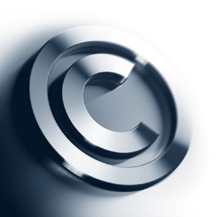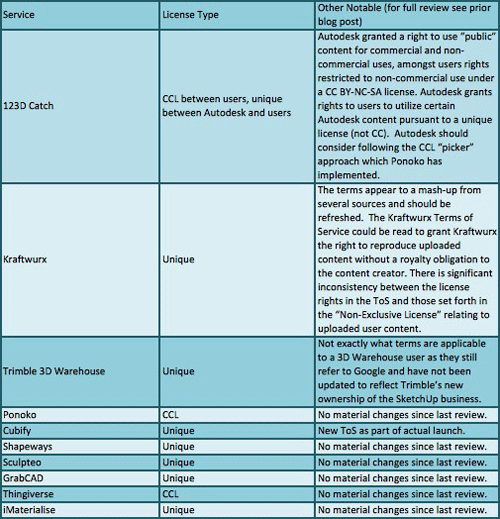By Tom Kurke, COO, Geomagic
In a two-part blog in March 2012, I made the argument that a"Community" license type is required for 3D content.
In these blog posts I first gave a little background on applicable intellectual property principles, reviewed how service providers were addressing these issues currently, and then made a proposal for what can and should be done in order to remove at least some of the legal grayness that exists (and that varies substantially from country to country). I believe that it doesn't matter which side of the argument you are on (e.g., intellectual property protection is already overbroad versus rights holders who believe more protection is needed), the conclusion is still the same: we have a looming problem.
 These blogs in their entirety can be found at: https://www.geomagic.com/en/community/beyond-the-box/the-call-for-a-harmonized-community-license-for-3d-content.-part/ (Part I) and https://www.geomagic.com/en/community/beyond-the-box/the-call-for-a-harmonized-community-license-for-3d-content.-part1/ (Part II).
These blogs in their entirety can be found at: https://www.geomagic.com/en/community/beyond-the-box/the-call-for-a-harmonized-community-license-for-3d-content.-part/ (Part I) and https://www.geomagic.com/en/community/beyond-the-box/the-call-for-a-harmonized-community-license-for-3d-content.-part1/ (Part II).
Since writing those entries the need for a harmonized approach has only grown. The pace at which the capture/create/modify/make ecosystem is changing is only accelerating. New market entrants are pushing the boundaries of content acquisition, while established players are moving down market with new consumer-oriented 3D printers intended for consumer/hobbyist use. Start-up companies are developing new technologies and approaches to round-trip data from the physical to digital and back to physical again. These are exciting times, and while intellectual property questions should certainly not stifle innovation or the pace of change, a framework should be established now for how to address issues that have arisen and will inevitably arise in the future.
In today's update I review and summarize the terms of service applicable to Autodesk's 123D Catch and Kraftwurx, and I refresh the reviews I have completed previously. I encourage people to read the prior blog posts in conjunction with this one. One macro-level trend that I did not note previously is that many of the sites restrict the use of downloaded content solely for non-commercial purposes. While on the one hand this might be understandable from the perspective of the site and content owner, from the perspective of the content user, this is perhaps an unexpected"gotcha," which makes them unwitting copyright infringers if they use downloaded content as part of a commercial endeavor.
Review of Services
123D Catch
For those of who you do not know, 123D Catch is an Autodesk photogrammetry application (consisting of a client application, whether on a desktop, phone or otherwise) and a web service for the creation of 3D models from uploaded photographs. It is the content capture piece of the 123D product family, descriptions of which can be found here: http://www.123dapp.com/create.
The terms of service can be found here: http://sitesupport.123dapp.com/entries/20059427-terms-of-service (last updated July 26th, 2012). Other terms of service are incorporated by reference into this agreement. They can be found here: http://usa.autodesk.com/adsk/servlet/item?siteID=123112&id=17784802.
The site provides for a"Gallery" function where people can upload and share models (see: http://www.123dapp.com/Gallery/) as well as connect to various fabrication services (i.e., currently laser cutting and 3D printing). iMaterialise, Ponoko, and Shapeways, among others, are listed as partners.
The terms of service applicable to 123Dapp.com (the location of the cloud service that provides support for 123D Catch and other Autodesk applications) incorporate a CCL (Creative Commons License) model for content shared amongst users but which differs when defining Autodesk's rights. Section 3 ("Your Content") outlines the allocation of IP rights in the service. It generally provides that if you agree to upload content to a public area of the service, you are allowing Autodesk to use that uploaded content for whatever purpose they desire (commercial, non-commercial, or otherwise). See specifically Section 3(b)(i). This section also provides that by uploading the content you warrant that you have all rights to do so.
Section 3(b)(ii) outlines the rights granted to other users of the service (and not to Autodesk) and provides that if you upload content to a public area of the site, you have agreed to grant other users of the service the right to re-distribute, re-use, modify, adapt, create derivative works, etc. for non-commercial purposes based on your uploaded publicly shared content in a manner that is consistent with the Creative Commons Attribution Non-Commercial Share Alike License (see: http://creativecommons.org/licenses/by-nc-sa/3.0/).
It's interesting that Autodesk reserves the right to make commercial use of uploaded "public" content but restricts use to "non-commercial" purposes by other users' (by incorporation of the CC BY-NC-SA 3.0) license schemes.
Kraftwurx
I apologize for not covering Kraftwurx in my initial run through of various service providers. Kraftwurx positions itself as "the Original community & marketplace for quality custom products, printed in 3D." Kraftwurx is based in Houston, Texas, and the company's vision "is to empower consumers for mass customization by 3D printing anything they could imagine." Kraftwurx describes itself as both a"marketplace and community."
The Kraftwurx terms can be found here under the heading"Non-Exclusive License": http://www.kraftwurx.com/nonexclusive-license-agreement as well as here: http://www.kraftwurx.com/terms-of-service defining terms of service.
According to the Terms of Service (ToS), by uploading content to Kraftwurx you agree that it does not violate the intellectual property rights of third parties. Per the Terms of Service, under the heading of"Content," while Kraftwurx disclaims ownership rights of uploaded content, Kraftwurx claims a broad license grant to uploaded content, without restriction to commercial or non-commercial purposes and in perpetuity.
The allocation of rights in the"Non-Exclusive License" relating to"Designs" is inconsistent with those in the ToS. Here, under the section titled"Licenses," Kraftwurx claims a license to publicly display, market, etc. the user-submitted designs for the purposes of creating products, and the user has the right to remove the design at any time (provided that Kraftwurx can continue to use it for marketing or other purposes, just not production). The applicable Royalty Rate can be set by the User (either as a % or a fixed dollar amount)
Under the section titled"Representations" at the very end of the"Non-Exclusive License," a user must represent among other things that: (a) he/she owns the design or it is in the public domain; (b) no one else claims ownership in the design (knowledge qualified); (c) the design doesn't infringe on the moral, privacy or other rights of third parties; and (d) Kraftwurx can produce physical representations of the design without infringing on the rights of third parties or requiring permission to do so.
Finally, Kraftwurx has a DMCA (Digital Millennium Copyright Act) notice here - http://www.kraftwurx.com/copyright-a-intellectual-property. Note that the DMCA, or safe harbors, would also apply to 3D printing service providers.
Trimble (was Google) 3D Warehouse
In April 2012 Trimble purchased the SketchUp business from Google including the 3D Warehouse along with a curious allocation of rights to content that had already been submitted (with a closing that apparently happened on or about June 1st, 2012). See: http://www.sketchup.com/intl/en/usernotice.html. Continuing use and access to the 3D Warehouse will now be governed by Trimble's terms, a preliminary set of which were linked through in the"User Notice" referenced above. However, the link resolves to an old set of Google 3D Warehouse terms (which are unchanged), see: www.sketchup.com/intl/en/3dwh/preview_tos.html.
Ponoko
No material changes noted. As I described before, Ponoko has clearly thought through the implications of IP on the capture or create/modify/make ecosystem with a very clear and explicit licensing scheme.
Thingiverse
No material changes noted. As with Ponoko, Thingiverse uses a range of Creative Commons licenses as part of a drop-down license picker.
There is some current controversy about whether Makerbot is moving to a closed-source model, and people have reviewed the ToS, found them objectionable, and have stated that the terms are recently changed (implying that this is consistent with some broader Makerbot business pivot to a closed-source model).
I can confirm that the ToS have not changed since at least February 12, 2012 (I have a hard copy print out of them).
GrabCAD
No material changes noted. Section 4 of their terms of service still provides that uploaded content may still only be used for"non-commercial" purposes - obviously a significant limitation if the user/contributor is looking to use or submit content as part of a commercial or fee-paying project.
Sculpteo
No material changes noted.
Shapeways
No material changes noted. Shapeways marks the license with the last change date, and this was February 2012.
Cubify (from 3D Systems)
Since the last review, 3D Systems has modified, cleaned up and tweaked the Cubify landing pages. When previously reviewed, Cubify was in the process of launching. The Cubify terms of service can now be found http://cubify.com/info/learn/terms_of_service.aspx.
Substantively the terms are similar as before. Cubify will allow for the download of hosted models under several license types, see Section 6 of the Terms of Service, specifically Sections 5(d), (e), and (f). These are a"standard royalty free license,""editorial license only" and"royalty free license with model release." In Section 6(7) 3D Systems disclaims IP responsibility for uploaded content and content delivered from third-party services and sources.
Section 7 now specifically covers Intellectual Property. Section 7(1) requires that a user only upload content that it owns the rights to (and agrees not to upload content that might be subject to third-party claims). Section 7(2) outlines rights granted to 3D Systems in order to display, market and ultimately produce content that has been uploaded, and it also grants third parties the right to view the content (in order to make a purchase decision, for example). Section 7(3) provides that if a user downloads and uses content from the site, they are SOLEY responsible for any intellectual property and other legal or clearance issues 3D Systems does not represent that the content hosted has been fully cleared or is moral/legal to produce in the jurisdiction of the person who downloads it.
To be able to become a contributor, a user must become a"Cubify Artist," see: http://cubify.com/learn/faq.aspx#CubifyArtist.
iMaterialize (from Materialise)
No material changes noted.
Summary of Approaches
